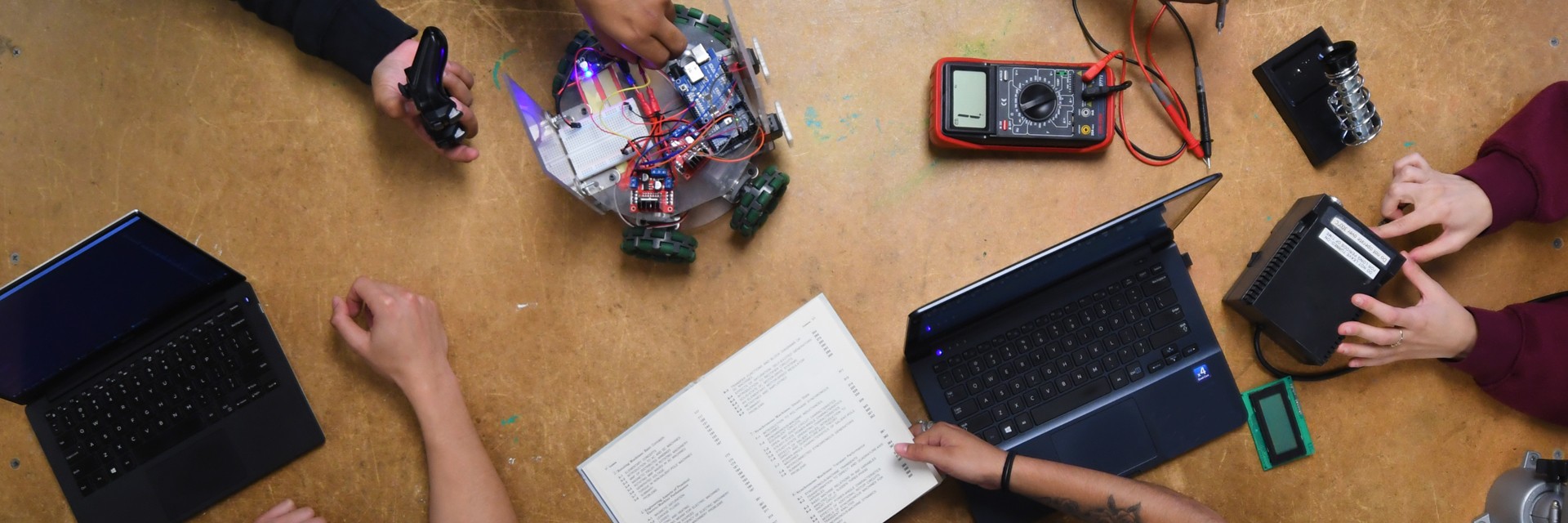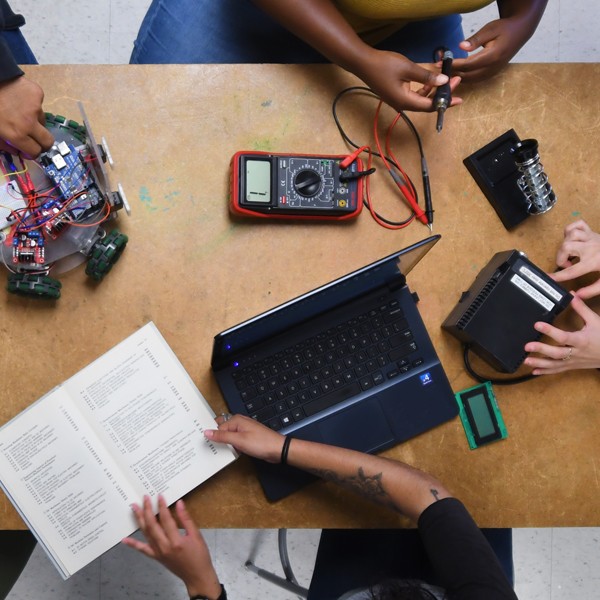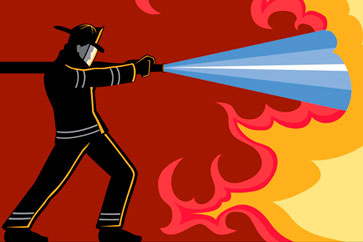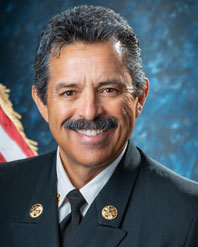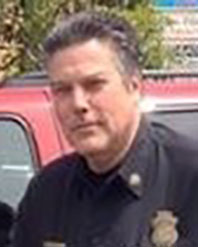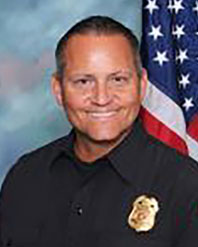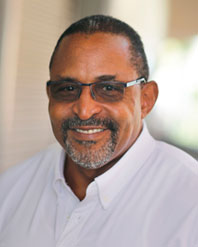Illustration: A Wesley Floyd
Cal State LA Fire Service Veterans Can’t Curb Their Enthusiasm
Despite long hours and often challenging conditions, a career in the fire service has many rewards. This is according to four people who have spent decades on the frontlines of firefighting and in leadership and teaching roles in the fire service. Each one earned a degree at Cal State LA and/or teaches in ECST’s unique Fire Protection Administration and Technology program.
The career trajectories of these distinguished veterans of the fire service vary, but the common threads are clear: the work is challenging physically and mentally, the profession has changed dramatically over the years—for the better—and they are all deeply committed to lifelong learning and educating young people interested in or new to the field.
One more thing: they really love their jobs!
ECST’s Bachelor of Science degree program in Fire Protection Administration and Technology is the only one of its kind in California. The program is designed to meet the needs of both aspiring and current fire service professionals for educational experiences that provide both technical and administrative skills that help them enter the field and get promotions into leadership positions. The department’s three full-time faculty have expertise in fire service leadership, fire protection engineering, and public safety education. Adjunct faculty include retired fire chiefs and directors of paramedic programs and wildland fire academies.
The fire service professionals who were interviewed and their professional backgrounds are as follows:
Chief Ralph Terrazas is Fire Chief of the Los Angeles Fire Department (LAFD), a position he has held since 2014. Over 35 years with the LAFD, he rose through the ranks to become the 18th Fire Chief of the LAFD and the first Latino to hold the department’s top job. In another first, he is the only Fire Chief of a U.S. city who has both a patent for a firefighting technology innovation (used to create a widely used application that simulates and projects how quickly a wildfire might spread) and an Emmy, the second most prestigious award in Hollywood after the Oscar, for a televised Public Service Announcement. Chief Terrazas earned a master’s degree in Public Administration from Cal State LA in 1995.
Chief Richard Beckman served the cities of San Gabriel and La Habra, California for nearly 40 years, starting as a firefighter and rising through the ranks to Division Chief in both cities’ fire departments. For more than 13 of those years, Chief Beckman was also a Fire Academy Senior Drillmaster at Rio Hondo College. He earned a bachelor’s degree in Fire Protection Administration and Technology from Cal State LA in 2002.
Chief Tracy Rickman has been a professional firefighter and educator for more than 35 years in the United States Air Force, private industry, and the cities of Pico Rivera and South Pasadena, California. In 1997, he was hired by Rio Hondo College and oversaw the Fire Academy and Regional Homeland Response Center in Santa Fe Springs, California until he retired in December 2019. Chief Rickman has an associates degree from the Community College of the Air Force, a bachelor’s degree from Park College, and a master’s degree in public administration from the University of Laverne, where he also completed the coursework for a doctoral degree. In 2016, he began teaching in ECST’s Fire Protection Administration and Technology program.
Chief Michael Thomas joined the faculty of Cal State LA’s undergraduate Fire Protection Administration and Technology program as an assistant professor in 2016 after a 36-year career with the LAFD where he rose to the rank of Fire Battalion Chief. While with the LAFD, he provided in-service training. He also served as an Adjunct Professor at Los Angeles Harbor Community College for 22 years. Professor Thomas earned a bachelor’s degree in Public Administration from Cal State LA in 1980.
Note: These fire service professionals were interviewed in November 2020. Their responses have been condensed and lightly edited.
Question: Chief Thomas, as a full-time faculty member in ECST’s Fire Protection Administration and Technology program, what’s important for readers to know about the program?
Chief Thomas: Historically, most people entering the fire service came out of the military or had construction experience that gave them valuable knowledge and experience. They learned the craft of firefighting on the job. Today’s students don’t have that experience, so they need to get knowledge in other ways.
The Fire Protection Administration and Technology program is a two-year degree completion program. Students transfer in after completing prerequisites at a community college. Once in the program, they learn about topics such as disaster preparedness, investigation, prevention, law, and building and construction. The third piece of a firefighter’s education is the fire academy where students are trained in fundamental firefighting skills and tasks. Some students who come here have already attended an academy or might already be working in the field. Others come here before going to the academy.
Firefighting is a competitive field. Earning an undergraduate degree from our program gives entry-level people a leg up in getting a job. For people already in the service, it’s often a requirement for promotions into leadership positions.
Question: What inspired you to become a firefighter?
Chief Terrazas: When I was in the third grade, my school had a Career Day and the local fire department showed up with a fire engine. At the age of 8, I got to shoot water out of fire hose. That was it. That’s what made me want to be a firefighter. As grew older, I briefly considered other professions. But I always came back to firefighting.
Chief Beckman: I had no real desire to become a firefighter. But as a young man, I ended up becoming a volunteer firefighter in my local community. I got really excited about the opportunity to help people. I also liked the camaraderie and military nature of the fire service. I decided to go to a fire academy for the training I needed. That was the beginning of my career.
Chief Rickman: I was 18 years old when I joined the Air Force and spent 8 years stationed in North Dakota. That’s where I was trained to be a firefighter. While on active duty in the Air Force, I continued my education. After leaving the service, I joined Northup Grumman as a firefighter with the B-2 bomber program. That was the start of my varied career.
Chief Thomas: I had a degree in public administration and was pursuing a career in criminal justice. In fact, I had decided to join the LA Police Department. While I was waiting to hear back, I ran into a friend who had been in the fire service for three years and he talked me into it. I never looked back.
Question: The fire service seems to attract lifelong learners. What has been your educational path?
Chief Rickman: I joined the Air Force right out of high school and was trained as a firefighter. While on active duty for eight years, I got an associates degree and an undergraduate degree. I have a master’s degree in public administration. I am ABD (all but dissertation) on a doctoral degree. Early on in my career, I started teaching and I’ve never stopped. Two years ago, there was an opening for an instructor in the program at Cal State LA. Mike Thomas recruited me. What got me into teaching and what keeps me going is the tenacity and motivation of the students.
Chief Beckman: I was thinking about going to law school. But then in 1981 I became a volunteer firefighter in my community. After a couple of years, I was hired into part- and full-time positions. Over the course of 20 years, I would bite off a few classes at a time. While working full-time, I got an associates degree, attended a fire academy’s executive development program, and got my undergraduate degree in the Fire Protection Administration and Technology program at Cal State LA. Getting my undergraduate degree was necessary to get promoted and to teach, which I’ve been doing almost my entire career.
Chief Terrazas: I got my undergraduate degree in public administration from San Diego State University and was hired by the LAFD when I graduated. After a few years, I wanted to continue to learn. I thought about getting a master’s degree. At the time, I was working in downtown LA and I wasn’t married. I looked into Cal State LA and realized that I needed just 12 courses to get a master’s in public administration. So, I took 1-2 courses a quarter. I never anticipated becoming Fire Chief. But a lot of the skills I learned at Cal State LA helped prepare me. I was taking a class during the Rodney King riots (1992) and some of my classmates were with the LAPD. We were able to share insights and analyze what had gone wrong. That was enormously valuable. I also learned about budgets and statistical analysis. These are skills I use all the time.
Question: How has the fire service changed over the years you’ve been in the profession?
Chief Thomas: Years ago, most fires were of structures, but improvements in building and construction and prevention has reduced the number of structure fires. At the same time, fires at the wildland-urban interface have increased. These fires validate that climate change is real. We don’t have enough people and resources to fight these fires and so we are developing new tactics for dealing with them. The situation has heightened interest in the fire service overall.
Chief Beckman: We have much more diversity in the fire service and that is refreshing. We’ve made great advancements, but we are not done yet. The professionalism of firefighting has also increased. The educational bar has been raised and more professionals are getting training and certifications. There is also more of a focus on safety. Because of the nature of firefighting and, for example, the risk of exposure to toxic chemicals, the profession has taken more measures to protect firefighters. Along with physical safety the profession has become much more aware of the psychological impacts of firefighting. The number one cause of death for firefighters related to their job is PTSD (post-traumatic stress syndrome). Also, as the profession has grown we’ve become much better at advocating for funding. Government funding is very competitive. We are now better able to compete for funding.
Chief Terrazas: During the interview process for Fire Chief, I was asked what the optimal LAFD would look like. I said it would be metric-driven, more sophisticated in its use of technology, community-focused, and it would reflect the people we serve. We have made progress on all of these fronts.
For example, we use technology a lot more in firefighting. We use the application based on my patent, which is called WiFire, to simultaneously produce an image of a fire and project its path to improve our situational awareness before we dispatch resources. We have a firefighting robot that is the first of its kind in the U.S. We use it when is too dangerous for firefighters to enter a building for fear of walls collapsing. We use drones instead of expensive helicopters to check for hot spots once a fire has been put out. And next summer, LAFD will be the first fire department in the country to take delivery of an electric fire engine like one being used at LAX.
The civilian labor force of LA includes women, Hispanics, African Americans, Asians, and Pacific Islanders. It is important that we look like them. In terms of recruiting, we work closely with high schools and run a lot of youth programs to get people interested in the profession early. Our new recruits often want to work in the neighborhoods where they live. It’s been a really great collaborative effort to increase diversity.
Question: What have been some of the most memorable events in your career?
Chief Beckman: I will never forget as a younger firefighter delivering my first baby. I was called to a house in a small community where I was working and a woman I knew was about to have her third child. She had wanted a home birth, but when the time came she called us to assist. Her other two children were very upset because she was in pain. Two other firefighters took them off to the side to keep them occupied while I helped with the delivery. A decade later, the woman brought her 10-year-old daughter by the fire station to say hello to me. That was great.
An especially rewarding project I worked on was figuring out a new way for getting firefighters who are trapped out of burning buildings. It used to be that your partner was expected to come in and get you. But that can’t always happen. We designed a 12-person “rapid intervention crew” of firefighters specially trained for the task. Working through the Foothill Training Officers Associations, over the course of a couple of years, we trained more than 700 firefighters to be crew members. These crews saved a lot of lives.
Chief Terrazas: Right now, the LAFD is heavily involved in COVID-19 testing. This was a project that Mayor Eric Garcetti felt strongly about, that the city needed a robust testing program. On the first day of testing, I was at the testing site with the president of the firefighters’ union to help. An important reason we were there was to show that if you had the right PPE, you could perform tests safely. More than 2 million people in the city of Los Angeles have been tested so far. Now, we’re working out what our role will be in vaccine distribution once vaccines are available.
Question: What would you say to a young person seeking a career in the fire service?
Chief Beckman: Everyone wants to know the fastest route into the fire service. My advice is to start early by joining a scout program, become a volunteer, do ride-alongs, join clubs or fraternities. Do whatever you can do to make connections with people who can help you.
Chief Thomas: I served more than 36 years as a first responder in the “The City of Angels,” and I wouldn’t trade a day of the experience. From wind-driven brush fires to earthquake catastrophes, I love LA.
Chief Terrazas: Something I often say is excellence occurs when an individual recognizes an opportunity and pursues it with passion. If you can find your passion and earn a living doing it, it becomes so much more than work. I love coming to work… I love doing what I do. How fortunate am I?
Note: The Fire Protection Administration and Technology program is currently accepting transfer students, and is served by three full-time faculty (Dr. Stephanie Nelson, Dr. Lily Chen, and Chief Michael Thomas), and several adjunct faculty (including Chief Tracy Rickman).
